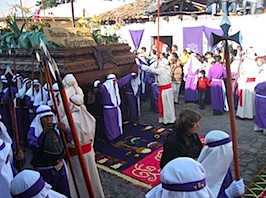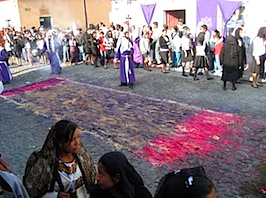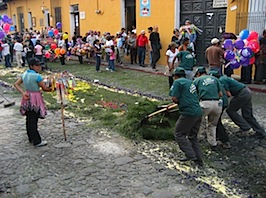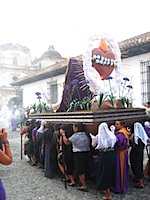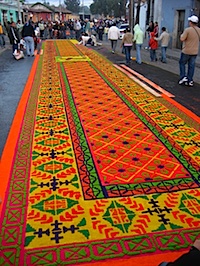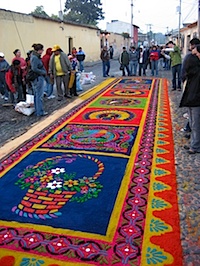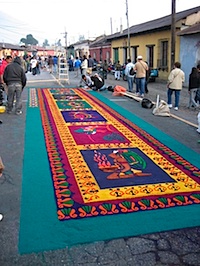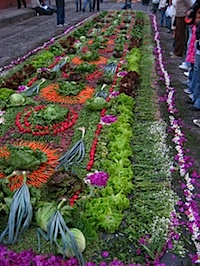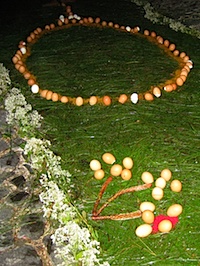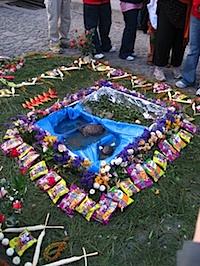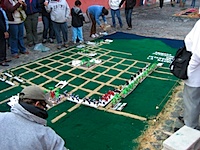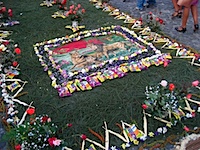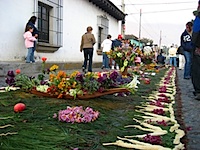 Hi guys! We have a lot to say here, so we’re going to do it together. This is me, Emily, in brown. Jaime/Fletch/Jim is in black. So here’s our story.
Hi guys! We have a lot to say here, so we’re going to do it together. This is me, Emily, in brown. Jaime/Fletch/Jim is in black. So here’s our story.
You might not remember Easter, as it was a few weeks back. For most of you, it was little more than looking around the house for brightly colored eggs and biting the ears off of chocolate bunnies. If you are particularly devout, you might have spent some time in church listening to sermons. But for Emily and I, Easter was a weeklong experience, Guate-style.
As previously mentioned, Guatemala is a predominantly Catholic country like much of Latin America. It’s been that way for just under 500 years, so they’ve worked up some pretty interesting and extreme ways to celebrate. Last week was semana santa, or “holy week”, where they celebrate the events surrounding the crucifixion of Jesus. For us, it was a chance to see the most elaborate and colorful celebration in central America, right here in Antigua Guatemala.
Having a working knowledge of the bible is very helpful to understanding the events of semana santa, but in case you’re not up to speed, I will try to fill you in as we go (and how ironic that he’s catching you up when I was the one who spent so much time in Catholic schools, hehe). Our first adventures of the fiesta had nothing to do with ancient history, however: we had to find a room. Hotels triple their prices during this holiday season, and we already live like paupers. Luckily, our friend Vera at the Dia Verde hotel was there to save us. Her hotel went form 50q/person a night to 185q/person a night, but when we called to reserve a room she said she would give us her smallest double for 185q total, if we didn’t tell any of the other guests. Needless to say, we brought her some cookies a few times during the week. It’s nice to have friends in random places!
Our second problem was with the buses. We were planning on leaving home Thursday morning, to save some money. But then we heard that on Thursday and Friday, many buses don’t run and we probably wouldn’t be able to get to Antigua. We changed our plan at the last minute Wednesday morning, hopping a Quiche bus when we got to Huehuetenango so we might get lucky and make the right connections and arrive in Antigua before the shutdown. I called Vera from the road, on the slim chance that she still had a room for Wednesday night as well. “Tienes suerte, Jaimito,” she said. “Todavia hay uno mas.” We were in luck, a room! We made every connection with only seconds to spare, and we arrived safely in Antigua an hour or two before sundown.
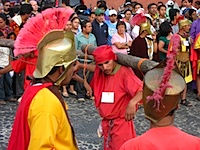 That evening we experienced our first procession. The crowd of onlookers first got our attention, then the Roman soldiers harrying along a few condemned prisoners that would be sharing crucifixion space with Jesus. We knew the big guy himself must be close behind. Before we could see it, we could hear it: orchestra music coming down the street, playing a somber tune heavy on the tuba and timpani. This was followed closely by the smell of frankincense, a cloud of which filled the street ahead. Soon a huge crowd of penitants dressed in purple robes emerged from the smokescreen, marching solemnly to the ominous music. Then the anda appeared: a beautifully carved, giant wooden float of sorts. It was borne upon the shoulders of a crowd of people, much as pallbearers carry a coffin. The anda made its way slowly but deliberately down the narrow cobblestone street, and atop it rode the figure of Jesus, bloodstained and tortured, bearing the cross.
That evening we experienced our first procession. The crowd of onlookers first got our attention, then the Roman soldiers harrying along a few condemned prisoners that would be sharing crucifixion space with Jesus. We knew the big guy himself must be close behind. Before we could see it, we could hear it: orchestra music coming down the street, playing a somber tune heavy on the tuba and timpani. This was followed closely by the smell of frankincense, a cloud of which filled the street ahead. Soon a huge crowd of penitants dressed in purple robes emerged from the smokescreen, marching solemnly to the ominous music. Then the anda appeared: a beautifully carved, giant wooden float of sorts. It was borne upon the shoulders of a crowd of people, much as pallbearers carry a coffin. The anda made its way slowly but deliberately down the narrow cobblestone street, and atop it rode the figure of Jesus, bloodstained and tortured, bearing the cross.
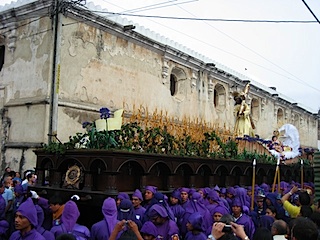 The first anda we saw had spaces for 80 bearers. Vera’s boyfriend explained to us that it’s a priviledge to be allowed to carry, and the bearers are assigned two numbers with their participation card: a number corresponding to a padded shoulder rest on the anda, and a second corresponding to which section of the route they would be carrying. This seems awfully organized for Guatemala, but I guess it has to be: when the anda gets heavy and they switch, they do it rather smoothly, and I never heard of one getting dropped.
The first anda we saw had spaces for 80 bearers. Vera’s boyfriend explained to us that it’s a priviledge to be allowed to carry, and the bearers are assigned two numbers with their participation card: a number corresponding to a padded shoulder rest on the anda, and a second corresponding to which section of the route they would be carrying. This seems awfully organized for Guatemala, but I guess it has to be: when the anda gets heavy and they switch, they do it rather smoothly, and I never heard of one getting dropped.
We were told a lot of different stories as to how one acquires a spot as a bearer: it’s handed down along family lines, it has to be bought with donations, it has to be earned by a lot of participation in church brotherhoods and communitiy activities. Likely, it’s a combination of the three. Vera was also carrying andas during the long weekend. She said, “My grandmother always did it, so now I do too. She told me the more it hurts, the more sins you’re atoning for on the walk.” What an old-school mentality. But sure enough, Friday and Saturday night Vera was dressed in what looked like funeral clothes, going out to carry the anda of Mary. Besides carrying, there are other interesting jobs relating to the procession:
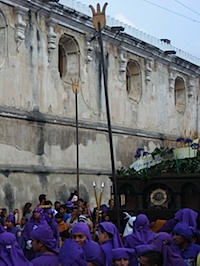 |
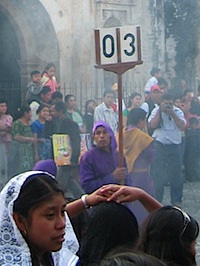 |
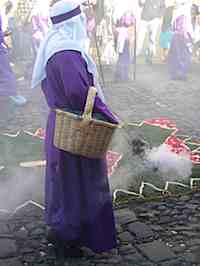 |
| There are a few guys in front with really tall decorated poles. The poles are the height of the float, and much like a pilot car in front of an oversized semi in the U.S., the poles are used to check if the float will fit under the power lines. If not, the decorative top of the poles is designed to act as a fork to grab low-hanging power lines and push them up and out of the way! | A different guy has a pole with numbers atop it, to let the waiting bearers know when their turn is about to come up. | And, of course, there are the various aforementioned jobs, like the censer swingers. They make the huge acrid cloud of frankincense that Joe’s mom refers to as “church fever”. |
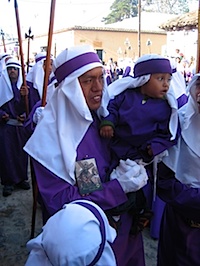 |
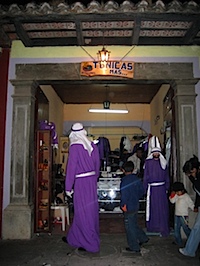 |
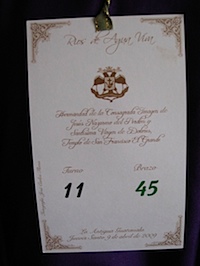 |
| If you want to carry the anda, you should start your training at an early age. | Here is a “ye olde tunic shop”, for all your purple robe needs. It’s called Tunics and More. But what more could you need? | And everyone needs a carry permit… and I don’t mean the kind of “carry permit” you can get in the States. |
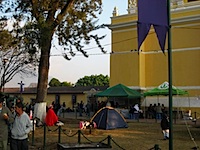 We slept in Thursday morning, anticipating a long night ahead. Many of the locals had warned us that the celebration doesn’t really stop from about Thursday morning until Sunday morning. Vera’s story confirmed one I’d heard from Guillermo, my host uncle from training. She said, “We Antiguenos are just used to not sleeping from Thursday until Sunday during Semana Santa.” Guillermo’s family of 6 stays in their grandfather’s tailor shop just off the main street, sleeping a bit if they get tired, but spending most of the time wandering the streets and enjoying the festivities. That sounds a lot more fun than this guy’s idea, camping in the central square of town. We made plans to meet up with them late on Thursday. This cracked me up, we found people pitching tents in public parks to be quite literally in the center of all the action. Maybe we should have done this instead of spending all that money on a room? Though for how infrequently we get to use real showers, the money is almost always worth it.
We slept in Thursday morning, anticipating a long night ahead. Many of the locals had warned us that the celebration doesn’t really stop from about Thursday morning until Sunday morning. Vera’s story confirmed one I’d heard from Guillermo, my host uncle from training. She said, “We Antiguenos are just used to not sleeping from Thursday until Sunday during Semana Santa.” Guillermo’s family of 6 stays in their grandfather’s tailor shop just off the main street, sleeping a bit if they get tired, but spending most of the time wandering the streets and enjoying the festivities. That sounds a lot more fun than this guy’s idea, camping in the central square of town. We made plans to meet up with them late on Thursday. This cracked me up, we found people pitching tents in public parks to be quite literally in the center of all the action. Maybe we should have done this instead of spending all that money on a room? Though for how infrequently we get to use real showers, the money is almost always worth it.
Antigua is a great city in which to get up and do yoga. Almost all hotels have rooftop terraces where I like to practice. Additionally the mornings are quiet and clear and the volcanos surrounding the city jut up in the distance, a lush green in color. This was the first the time I’ve been to Antigua and woken up to find a haze dulling the view of the volcanos. It was strange. Then I thought, it must be a cloud of procession smoke that just doesn’t go away until Sunday. Sure enough, every morning was hazy until Monday morning rolled around.
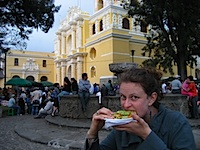 After a day of watching processions march around the city, we were getting hungry. Scores of food vendors had overrun the churchyard in front of La Merced (one of the fancier churches in town), and tasty smells were eminating from the stalls. Emily broke down and took a chance with street food after watching one lady in particular to see that she was not up to any particularly unsanitary practices. The churrascos we ended up eating were delicious, and we have yet to suffer any ill effects. Thing is, all through training we were warned to stay away from street food, and even though it smelled delicious, I did. What’s funny is that while visiting Morocco, a country with a similar level of development and sanitation as Guatemala, we survived off street food, and it never hurt me. Jaime had some issues, but I was good to go. I’d toyed with the idea of street food here for a long time, but since the amoebas incident I’ve been too scared to eat it. This week it seemed like I wasn’t accepting the culture we were celebrating in if I didn’t partake in their food, so I plucked up the courage and dove in. Indeed, it was delish. As my friend Tim (another volunteer) said when I gasped after seeing him stick his toothbrush under the faucet in a hotel, “Hey, I did everything right during training, and I was sick the whole time (and he did look strikingly like a skeleton for 3 months). I don’t concentrate on doing everything right anymore, and I haven’t had any problems.” I still don’t put my toothbrush under the faucet, though.
After a day of watching processions march around the city, we were getting hungry. Scores of food vendors had overrun the churchyard in front of La Merced (one of the fancier churches in town), and tasty smells were eminating from the stalls. Emily broke down and took a chance with street food after watching one lady in particular to see that she was not up to any particularly unsanitary practices. The churrascos we ended up eating were delicious, and we have yet to suffer any ill effects. Thing is, all through training we were warned to stay away from street food, and even though it smelled delicious, I did. What’s funny is that while visiting Morocco, a country with a similar level of development and sanitation as Guatemala, we survived off street food, and it never hurt me. Jaime had some issues, but I was good to go. I’d toyed with the idea of street food here for a long time, but since the amoebas incident I’ve been too scared to eat it. This week it seemed like I wasn’t accepting the culture we were celebrating in if I didn’t partake in their food, so I plucked up the courage and dove in. Indeed, it was delish. As my friend Tim (another volunteer) said when I gasped after seeing him stick his toothbrush under the faucet in a hotel, “Hey, I did everything right during training, and I was sick the whole time (and he did look strikingly like a skeleton for 3 months). I don’t concentrate on doing everything right anymore, and I haven’t had any problems.” I still don’t put my toothbrush under the faucet, though.
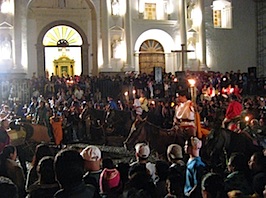 Once night fell, we moved to the cathedral where they were having the trial of Jesus. Actors dressed as Pontius Pilate, Jewish clergymen, and Roman soldiers enacted a pretty elaborate dramatization. There were TV news crews and everything. Though in what seems more and more to be “typical” fashion for big public shows, there was a lot of microphone malfunctioning which made it difficult to hear. Good thing I know the story well, or might not have known what was happening!
Once night fell, we moved to the cathedral where they were having the trial of Jesus. Actors dressed as Pontius Pilate, Jewish clergymen, and Roman soldiers enacted a pretty elaborate dramatization. There were TV news crews and everything. Though in what seems more and more to be “typical” fashion for big public shows, there was a lot of microphone malfunctioning which made it difficult to hear. Good thing I know the story well, or might not have known what was happening!
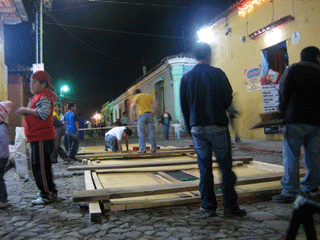 As the evening wore on, more and more people could be seen gathering in the streets. They were out to watch all the craftsmen and devoted worshippers making alfombras, or carpets, for Jesus to walk over during his procession to the crucifixion at sunrise. Most of the alfombras are made from colored sawdust, in extremely elaborate patterns. Dozens of workers toil on each one all night long, using stencils, brushes, and improvised tools to create elaborate works of art. Some alfombras are sponsored by businesses, some are built as a family activity, and a few are the work of individuals. When the procession passes over them hours later, they are completely destroyed. There is something profoundly moving about all that work and beauty going into such a temporal thing. They do it for god, as a sacrifice.
As the evening wore on, more and more people could be seen gathering in the streets. They were out to watch all the craftsmen and devoted worshippers making alfombras, or carpets, for Jesus to walk over during his procession to the crucifixion at sunrise. Most of the alfombras are made from colored sawdust, in extremely elaborate patterns. Dozens of workers toil on each one all night long, using stencils, brushes, and improvised tools to create elaborate works of art. Some alfombras are sponsored by businesses, some are built as a family activity, and a few are the work of individuals. When the procession passes over them hours later, they are completely destroyed. There is something profoundly moving about all that work and beauty going into such a temporal thing. They do it for god, as a sacrifice.
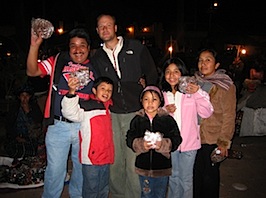 It was at about this time that we got a call from Memo, the 12-year-old from my host family during training. They were all in town, so we decide to meet at 10pm. Of course, you can never expect a 12-year-old to be timely, and if he’s Guatemalan… yeah, we found him and his whole family at about midnight in front of La Merced.
It was at about this time that we got a call from Memo, the 12-year-old from my host family during training. They were all in town, so we decide to meet at 10pm. Of course, you can never expect a 12-year-old to be timely, and if he’s Guatemalan… yeah, we found him and his whole family at about midnight in front of La Merced. 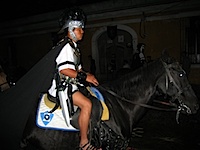 We got there just in time for the Sentencing, where the Romans come out and tell everyone that Jesus is to be crucified. Here we see some Romans on horseback bringing the bad (good?) news. The horsemen leave from the church and ride around the city telling everyone of the crucifixion taking place in the morning. Pretty cool. Emily and I bought giant chocolate cookes and gave them out to all 4 kids, as well as Guillermo and Lucy. I told the kids the sugar was to keep them awake all night. I’d had a large cup of coffee at 9pm to keep going. Though if their hero Jaime is around, they don’t usually need anything else to keep them going. We have to act like we’re they’re cool aunt and uncle, so we don’t forget how to do that once we get home. A good time was had by all. Except Jesus, that is. He was having a bad day, and it would only get worse.
We got there just in time for the Sentencing, where the Romans come out and tell everyone that Jesus is to be crucified. Here we see some Romans on horseback bringing the bad (good?) news. The horsemen leave from the church and ride around the city telling everyone of the crucifixion taking place in the morning. Pretty cool. Emily and I bought giant chocolate cookes and gave them out to all 4 kids, as well as Guillermo and Lucy. I told the kids the sugar was to keep them awake all night. I’d had a large cup of coffee at 9pm to keep going. Though if their hero Jaime is around, they don’t usually need anything else to keep them going. We have to act like we’re they’re cool aunt and uncle, so we don’t forget how to do that once we get home. A good time was had by all. Except Jesus, that is. He was having a bad day, and it would only get worse.
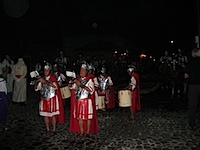 By this point, it was about 1:30 am on Friday, and we were pooped. We went back to the hotel for a couple hours of sleep, and were back up in time for the procession that started at 4am. We got up a little bit early to catch the Romans that move around town tooting horns and letting everyone know that Jesus was going to get crucified. Then, promptly at 4am, Jesus and his anda left the church for his procession towards cucifixion. It was a giant re-enactment of The Way of the Cross.
By this point, it was about 1:30 am on Friday, and we were pooped. We went back to the hotel for a couple hours of sleep, and were back up in time for the procession that started at 4am. We got up a little bit early to catch the Romans that move around town tooting horns and letting everyone know that Jesus was going to get crucified. Then, promptly at 4am, Jesus and his anda left the church for his procession towards cucifixion. It was a giant re-enactment of The Way of the Cross.
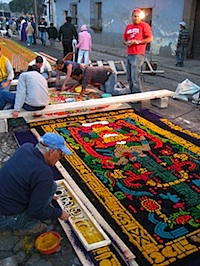 We followed him a few blocks, then headed off towards the calle ancha, the big street at the end of the town, to see the Big League alfombras he would be walking over in an hour. You see, the most elaborate carpets are built on the calle hancha because it is really wide (it’s the route the buses take through town) and it’s smooth (asphalt, unlike the cobblestones that cover the rest of Antigua’s streets). I uploaded a tiny video of these artists working; it’s on YouTube right here. We spent the next few hours gawking at the amazing art, and almost missed the fact that the sun came up somewhere around 6am. This is great, because we were able to get some pictures of the full beauty of the carpets with natural sunlight.
We followed him a few blocks, then headed off towards the calle ancha, the big street at the end of the town, to see the Big League alfombras he would be walking over in an hour. You see, the most elaborate carpets are built on the calle hancha because it is really wide (it’s the route the buses take through town) and it’s smooth (asphalt, unlike the cobblestones that cover the rest of Antigua’s streets). I uploaded a tiny video of these artists working; it’s on YouTube right here. We spent the next few hours gawking at the amazing art, and almost missed the fact that the sun came up somewhere around 6am. This is great, because we were able to get some pictures of the full beauty of the carpets with natural sunlight.
It was really cool to me how the entire city just forgets about sleeping for this weekend. The streets are packed no matter the hour and there’s a carnival spirit in the air; even during the days everyone wanders the streets in black because they’re supposed to be sad it feels more exciting than sad. I was riding on all the energy around me, and the desire to see more carpets. So many of them were breathtaking, ten and twelve hours of solid work after who knows how many hours of planning the design and gathering materials, and in a ten minute stretch, for some of the longest carpets, they’re all gone. We walked more of Antigua in that morning than any other time we’ve been there.
Now you gotta understand, these beautiful carpets get completely DESTROYED witin hours of being completed. Here we have a “before” and “after” of the whole process, as the procession moves around town walking over alfombras. Then, a few minutes later, the dedicated folks of the Antigua street cleaning crew come by. I am sure they dread Holy Week. Or maybe it’s the street cleaners’ time to shine. 🙂
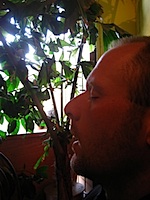 By about 8am, we were shot. And hungry. So we stopped by one of my favorite breakfast places, the Bagel Barn (yeah, yeah, a touristy place. But it’s cheap, it gives a volunteer discount, and it’s yummy). We ordered a quick bite to eat, and I promptly fell asleep sitting up before the food arrived. I know this because mean old Emily took a picture. This was the signal that we should go home and rest some more. I did not order coffee with this breakfast since the goal was to make it back to our hotel and crash. As he feel asleep waiting for the food, I had my feet propped up on the chair across from me resting my weary bones. Since Antigua has all cobbled streets, and we’d been walking on them for the better part of 24 hours, our hips and legs were absolutely aching. The last thing I remember before dropping off to sleep at the hotel was the throbbing sensation in my feet.
By about 8am, we were shot. And hungry. So we stopped by one of my favorite breakfast places, the Bagel Barn (yeah, yeah, a touristy place. But it’s cheap, it gives a volunteer discount, and it’s yummy). We ordered a quick bite to eat, and I promptly fell asleep sitting up before the food arrived. I know this because mean old Emily took a picture. This was the signal that we should go home and rest some more. I did not order coffee with this breakfast since the goal was to make it back to our hotel and crash. As he feel asleep waiting for the food, I had my feet propped up on the chair across from me resting my weary bones. Since Antigua has all cobbled streets, and we’d been walking on them for the better part of 24 hours, our hips and legs were absolutely aching. The last thing I remember before dropping off to sleep at the hotel was the throbbing sensation in my feet.
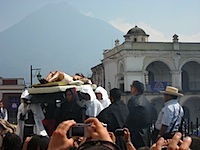 We got up in the early afternoon and headed to the main square to see if anything was going on. By luck, we managed to get there right when they were taking Jesus down from the cross. I don’t know why, but the crowd up front wasn’t too tight and we got a really good view of the Lamb of God up close. They loaded him up on some pallbearers and took him into the cathedral, causing a rush of people that we narrowly avoided as they tried to get into the church to see him one last time before they “sealed the tomb”. Notice in the background of this photo there is a volcano just barely visible throught he haze; that is the processional smoke I was talking about. It just sat over the entire city all weekend long.
We got up in the early afternoon and headed to the main square to see if anything was going on. By luck, we managed to get there right when they were taking Jesus down from the cross. I don’t know why, but the crowd up front wasn’t too tight and we got a really good view of the Lamb of God up close. They loaded him up on some pallbearers and took him into the cathedral, causing a rush of people that we narrowly avoided as they tried to get into the church to see him one last time before they “sealed the tomb”. Notice in the background of this photo there is a volcano just barely visible throught he haze; that is the processional smoke I was talking about. It just sat over the entire city all weekend long.
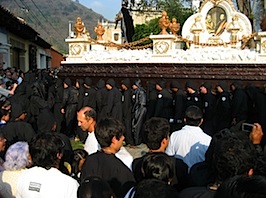 Once Jesus got killed, things changed up a bit. Whereas the earlier processions were robed entirely in purple, now they all wore robes of black. But this didn’t at all dampen their enthusiasm for carrying giant floats around town!
Once Jesus got killed, things changed up a bit. Whereas the earlier processions were robed entirely in purple, now they all wore robes of black. But this didn’t at all dampen their enthusiasm for carrying giant floats around town!
After our little nap to keep us going from a whole night of missed sleep, Jaime’s spirit, and his legs, were less than enthusiastic about watching all the floats go by. I kept dragging him from one place to another. There was so much to see, we ran ourselves ragged. We thought we’d go back to the hotel, shower, and get ready to go out for the evening, but as we got ready to leave we noticed the door was blocked by an assembled crowd, and decided to wait rather than try and push our way through. I was sitting in the kitchen window watching the beginnings of another processions unfolding, at first below me, and then at eye level. I shouted at Jaime to come look! Like we’d never seen this before…but somehow it was still pretty interesting. Once the procession finished, we decided “going out” was really too ambitious, so we went to the park a block away for a quick dinner, and then went to bed.
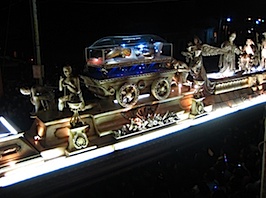 Friday evening I was sitting in our room and chatting with my mom online. Then I heard it, faint at first, then growing: timpani and tuba, a somber funeral dirge. Emily was yelling at me from the kitchen to com see, so I joined her in the window. Soon thereafter, a cloud of incense rolled in like morning fog. I looked out the window to see Dead Jesus float right by the window, carried on the shoulders of a hundred men (I counted). It took about five minutes for the anda to get past the hotel, because it had to go backwards and forwards Austin-Powers style to get around the corner of the street.
Friday evening I was sitting in our room and chatting with my mom online. Then I heard it, faint at first, then growing: timpani and tuba, a somber funeral dirge. Emily was yelling at me from the kitchen to com see, so I joined her in the window. Soon thereafter, a cloud of incense rolled in like morning fog. I looked out the window to see Dead Jesus float right by the window, carried on the shoulders of a hundred men (I counted). It took about five minutes for the anda to get past the hotel, because it had to go backwards and forwards Austin-Powers style to get around the corner of the street.
Once it was past, then followed the orchestra, then the backup carriers, then… two guys pushing the generator cart providing all the power for the nighttime lighting effects.
After Jesus was dead, Saturday’s processions were mostly Mary. Mary is interesting because she follows Jesus when he’s carrying the cross, but once he’s dead, she just wanders the streets in sadness by herself. This is the chance for the women to participate in the andas as well. Mary’s float is smaller, but does all the same stuff as the Big Guy. This does indeed mean the andas are sex segregated. Only men carry the largest andas depicting christ, and only women carry the smaller floats of Mary. But the sad, wandering Mary was really touching to me. She just looks lost without the rest of the great big procession.
The rest of the weekend was a blur of procession after procession, many of them similar to the first one. Here follows a selection of some of the more beautiful or interesting alfombras we saw.
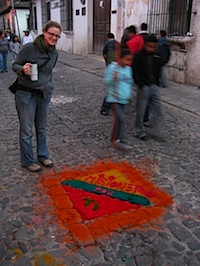 Oddly, Sunday was pretty quiet. I think they did a procession early in the morning when Jesus rose from the dead, but it wasn’t any grand thing. I expected something like a cacophony of church bells ringing throughout the city, and joyous choirs. But if there was that it wasn’t joyous enough to wake me from my slumber, which makes me think it didn’t happen. Our hotel was right in the middle of things. But anyway… This was our very happy vacation. That’s why I look very happy in this photo (also my hot chocolate in the mug was tasty). After Jaime did his whirlwind trip to the US and back, he was pretty underwhelmed by the idea of leaving our home again any time soon. I BEGGED him to do this trip with me. He didn’t want to travel. Then I BEGGED him some more. The thing that he should have figured out by now is, when it comes to fun, I have some pretty great ideas. And once he stops grumping about me making him do stuff, he’s super fun to do things with, too. 🙂 Semana Santa in Antigua was a pretty outrageous fun time.
Oddly, Sunday was pretty quiet. I think they did a procession early in the morning when Jesus rose from the dead, but it wasn’t any grand thing. I expected something like a cacophony of church bells ringing throughout the city, and joyous choirs. But if there was that it wasn’t joyous enough to wake me from my slumber, which makes me think it didn’t happen. Our hotel was right in the middle of things. But anyway… This was our very happy vacation. That’s why I look very happy in this photo (also my hot chocolate in the mug was tasty). After Jaime did his whirlwind trip to the US and back, he was pretty underwhelmed by the idea of leaving our home again any time soon. I BEGGED him to do this trip with me. He didn’t want to travel. Then I BEGGED him some more. The thing that he should have figured out by now is, when it comes to fun, I have some pretty great ideas. And once he stops grumping about me making him do stuff, he’s super fun to do things with, too. 🙂 Semana Santa in Antigua was a pretty outrageous fun time.
So, that’s about it. This has to be the longest post we’ve ever made, so I hope it was worthwhile and not too boring. Emily’s posing with the smallest alfombra we came across, apparently made by an individual or tiny family. I like it, because it reminds me of the do-it-yourself nature of Guatemalans, as well as their hands-on participatory approach to their relationship with God. In all, it sortof sums up what Semana Santa is about in Guatemala.
